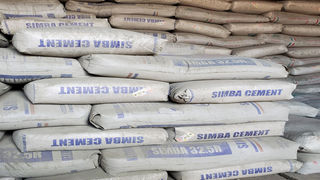
Bags of cement in a hardware shop. Inflation continues to affect the purchasing power of individuals in the construction sector. PHOTO/ISAAC KASAMANI
|Prosper
Prime
How inflation is affecting real estate investment
What you need to know:
- Some developers are putting their projects on hold as most construction materials have almost doubled, while others have tripled in prices
- It is not a good time to construct for future consumption because you may not make a good projection
Real estate investors are placing their bet on oil and gas investments to shore up property demand amidst a tight economic space.
The real estate market largely interacts with the investment environment.However, the current uncertainty as a result of rising inflation and the weakening purchasing power of the shilling is likely to affect the operational costs for property investment, according to a July Knight Frank real estate market report.
The increasing cost of living is already having ripple effects across the board which is necessitating frugal business strategies in the slower than anticipated pace of economic recovery.
Building, mortgage and construction services have registered noticeable negative credit growth rates with less demand for loans for such services from banks in the last few months, according to a June Monetary report from Bank of Uganda.
Inflation in eats into credit market
The Central Bank shows this could be a sign that the soaring inflation is filtering through credit markets.
Catherine Natenza, a board member at the Association of Real Estate Agents (AREA), says some developers are putting their projects on hold as most construction materials have almost doubled, while others have tripled in prices.
“It becomes hard especially for developers who are building for sale, and yet the cost calculation made has totally changed. Imagine, a bag of cement is now between Shs25,000 and Shs40,000,” Natenza says.
This is distorting sale projections for developers and investors, according to Nanteza, and yet developers cannot increase rent to match up.
Natenza, in her analysis of the current economic trends says, “It is not a good time to construct for future consumption because you may not make a good projection.”
Vaolah Amumpaire, the proprietor of Wena Hardware, an online store, says inflation has, and continues to affect the purchasing power of individuals in the construction sector.
“They can no longer buy as much as they used to,” she quipped during an interview with Prosper Magazine.
Amumpaire notes that cement has shot up ranging between 2,000 and 5,000 depending on the brand, but notes that this is a drop from the over Shs10,000 price difference.
“It goes back to volume, clients start off by asking for 100 bags. But when they get to know the price, then they reduce to 80 bags. That shows they are constrained but have a need,” she says.
This explains why some contractors are slowing down on construction.
“If you had agreed to develop a property at Shs100 million, now the cost of developing the same property has gone up by almost 5-10 percent. It is extremely expensive for contractors to proceed with such property,” Amumpaire observes.
A number of factors have been put forward to explain this rising phenomenon.
Covid- 19 and the current Russia-Ukraine war have affected the supply chain especially importation of raw materials causing a price hike in construction materials.
“Almost all construction materials work hand in hand, there’s no construction material that is manufactured that has all its raw materials locally sourced,” Amumpaire says.

Tiles on sale in Kampala. Covid-19 and the current Russia-Ukraine war have affected the supply chain especially importation of raw materials causing a price hike in construction materials. PHOTO/ Isaac Kasamani
Dollar rate
The dollar rate is also affecting manufacturers forcing most to import at a higher cost.
Suppliers in the construction industry are already feeling the pinch. Amumpaire says some are failing to fulfill orders because of a shortage of raw materials, which started during the lockdown.
Phillip Kimbugwe, a developer at Saif Properties, says this has forced companies to increase prices on condominium titles.
"Now, a bank can’t give you a mortgage below 17 percent. Some of our partner banks have been giving loans to our clients at 16.8 percent but then right now it is at 17.5 percent. This came as a result of the Bank of Uganda increasing all bank mortgage rates by 2.5 percent,” Kimbugwe says.
Kimbugwe says they are engaging their clients on price changes from suppliers to justify the high apartment costs.
Bank of Uganda paints a more ‘glossy’ picture of the economy as the oil industry moves into the development stage.
Last week, Total Energies said the first oil drilling rig is expected in Uganda by November this year, and will support the company’s oil drilling operations for the 400 oil wells in Buliisa and Nyowa districts.
Therefore, the Central Bank projects that in the medium-term, the economy will grow at 6 - 7 percent supported by public and private investments in the oil sector.
Real estate developers are using oil and gas as a yardstick for the general outlook of the real estate market with Knight Frank projecting that approximately 90,000 square metres of office space is expected in the next 12 to 24 months.
Nanteza says the oil and gas sector has increased the demand for real estate. However, the impact is yet to be felt with the actual demand trickling at a slow pace.
The expectation is largely on expatriates at the end of the year, and throughout the next year.
Expatriates will require the luxury or high-end property for office and residential, whereas others will go to Hoima district.
“Some companies have already started booking housing for their workers. We have seen companies looking for 40 condominiums in one place, and others are looking for 50-plus apartments,” Natenza says.

Wheelbarrows on sale at a hardware shop in Kampala. It is not a good time to construct for future consumption because you may not make a good projection. PHOTO/Isaac Kasamani
Growth and outlook
Real estate growth has in the last six months been driven, in part, by the full reopening of the economy, increased start- up funding, and the signing of the Final Investment Decision for oil and gas activities.
A Knight Frank real estate market report published in July shows the demand for property in the first half of the year was driven by financial services, telecom services, health, businesses, start- ups, industries as well as government agencies.
The demand has been either from new entrants or existing firms that were expanding or relocating.
The take-up has also been registered from occupiers who had previously downsized at the onset of the pandemic and are currently seeking to re-occupy the spaces they had relinquished.
As a result, Knight Frank registered inquiries increasing by 20 percent in the first half of 2022 as compared to the same period in 2021.
Similarly, Grade A office occupancy were up by 11 percent while grade AB occupancy improved slightly by 2 percent in the same period, largely attributed to existing occupiers increasing their space take-up.
This trend is recorded to have started at the end of 2021, with market evidence from a Stanbic bank baseline report indicating tenants have more demand for the newer Grade A office buildings that feature large –open layout floors and state-of-the-art design and safety characteristics. This is emanating from companies in the oil and gas, financial services, government parastatals and engineering sectors.
In the retail sector, a growing trend is slowly impacting occupancy in downtown retail centres as they compete with the suburbs to attract traders.
The lower rents in the neighbourhood shopping centres as compared to rates charged in downtown retail centres have attracted tenants, who are striving to minimise operational and occupancy costs.
Residential market
In the period under review, the prime residential market opened up to increased sale and rental activity, on the back of the return of expatriates to the country and growing activity in the oil and gas sector.
Apartments in the upscale neighbourhoods of Kololo, Naguru, and Nakasero were in high demand, with noticeable interest in one- and two-bedroom options. As a result, prime residential occupancy increased by 3 percent, while rents maintained relative stability.
Rising demand for prime residential accommodation is currently dominated by tenants in the oil and gas sector.
With Masindi earmarked as a supply terminal and logistical hub for the oil activities, and Luwero and Nakasongola designated as logistics and supply terminal’s transit routes.
More infrastructure development in these areas to support the ongoing activities and provide accommodation for project staff and the expatriates is expected. Tenants continue to drive harder rent bargains, and in most cases getting them.
This is also coupled with the fact that they are taking up numerous residential units which further strengthens their bargaining position.
In terms of number of units, the residential apartment market in Kololo is the most robust in Kampala.
Kololo makes up approximately 40 percent of all the housing units in the affluent suburbs and at least 60 percent of the prime construction pipeline.
Pipeline activity in prime suburbs increased by 13 percent, with at least 340 apartment units expected on the market in the next 12 to 24 months, 85 percent of which are three-bedroom units.
However, Knight Frank projects that the increasing stock of apartments especially in the suburbs of Kololo and Naguru is likely to contribute to residential market over supply woes in the long term, resulting in landlords revising rents downwards in order to reduce vacancies.
Knight Frank’s managing director, Judy Rugasira, says the office market is likely to see a review of escalation clauses in lease agreements on the back of growing discussions among stakeholders on the topic as a result of constrained incomes.
“The reviews are likely to incorporate biennial rates as compared to the annual escalation rates that were the market norm. This is likely to happen on a case-by-case basis rather than as a general rule,” she notes.




